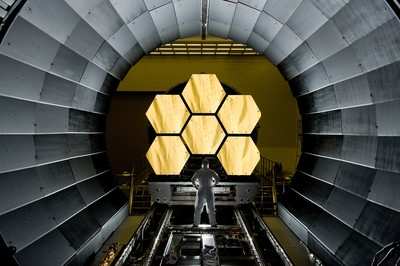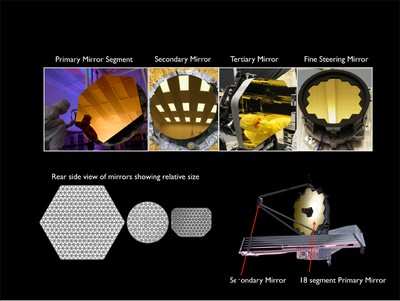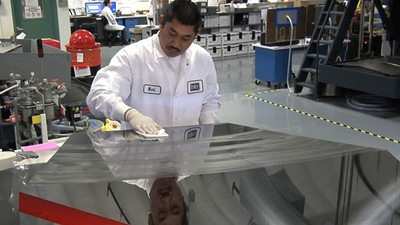Tue, Jul 05, 2011
Accuracies Of Less Than One-Millionth Of An Inch Required
Mirrors are a critical part of a telescope. The quality is
crucial, so completion of mirror polishing represents a major
milestone. All of the mirrors that will fly aboard NASA's James
Webb Space Telescope have been polished so the observatory can see
objects as far away as the first galaxies in the universe.

The Webb telescope is comprised of four types of mirrors. The
primary one has an area of approximately 29.9 square yards, which
will enable scientists to capture light from faint, distant objects
in the universe faster than any previous space observatory. The
mirrors are made of Beryllium and will work together to relay
images of the sky to the telescope's science cameras. "Webb's
mirror polishing always was considered the most challenging and
important technological milestone in the manufacture of the
telescope, so this is a hugely significant accomplishment," said
Lee Feinberg, Webb Optical Telescope manager at NASA's Goddard
Space Flight Center in Greenbelt, MD.

The mirrors were polished at the L3 Integrated Optical Systems -
Tinsley in Richmond, CA. to accuracies of less than one millionth
of an inch. That accuracy is important for forming the sharpest
images when the mirrors cool to -400 degrees F (-240 degrees C) in
the cold of space. "The completion of the mirror polishing shows
that the strategy of doing the hardest things first has really paid
off," said Nobel Prize Winner John C. Mather, Webb's senior project
scientist at Goddard. "Some astronomers doubted we could make these
mirrors."
After polishing, the mirrors are being coated with a
microscopically thin layer of gold to enable them to efficiently
reflect infrared light.

NASA has completed coating 13 of 18 primary mirror segments and
will complete the rest by early next year. The 18 segments fit
together to make one large mirror 21.3 feet across. "This milestone
is the culmination of a decade-long process," said Scott
Willoughby, vice president and Webb Telescope Program manager for
Northrop Grumman Aerospace Systems. "We had to invent an entire new
mirror technology to give Webb the ability to see back in
time."
More News
He Attempted To Restart The Engine Three Times. On The Third Restart Attempt, He Noticed That Flames Were Coming Out From The Right Wing Near The Fuel Cap Analysis: The pilot repor>[...]
Make Sure You NEVER Miss A New Story From Aero-News Network Do you ever feel like you never see posts from a certain person or page on Facebook or Instagram? Here’s how you c>[...]
From 2009 (YouTube Edition): Leading Air Show Performers Give Their Best Advice for Newcomers On December 6th through December 9th, the Paris Las Vegas Hotel hosted over 1,500 air >[...]
Aero Linx: NASA ASRS ASRS captures confidential reports, analyzes the resulting aviation safety data, and disseminates vital information to the aviation community. The ASRS is an i>[...]
“For our inaugural Pylon Racing Seminar in Roswell, we were thrilled to certify 60 pilots across our six closed-course pylon race classes. Not only did this year’s PRS >[...]
 NTSB Final Report: Rutan Long-EZ
NTSB Final Report: Rutan Long-EZ ANN FAQ: Turn On Post Notifications
ANN FAQ: Turn On Post Notifications Classic Aero-TV: ICAS Perspectives - Advice for New Air Show Performers
Classic Aero-TV: ICAS Perspectives - Advice for New Air Show Performers ANN's Daily Aero-Linx (06.28.25)
ANN's Daily Aero-Linx (06.28.25) Aero-News: Quote of the Day (06.28.25)
Aero-News: Quote of the Day (06.28.25)





